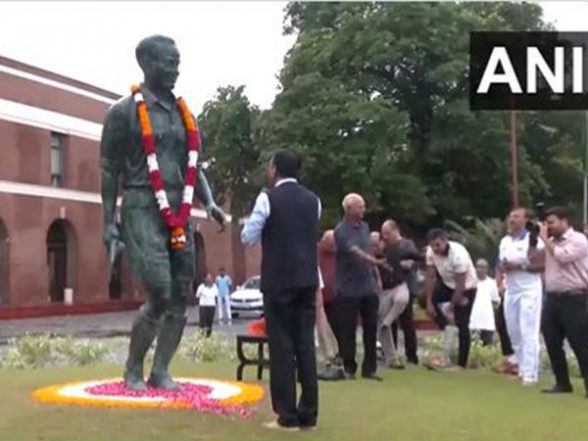Dhaka: Thousands of people squatted in monasteries, pagodas and schools on Sunday, seeking shelter from a powerful storm that battered Myanmar’s shores, ripping roofs off buildings and killing at least three people. Typhoon Mocha made landfall on Sunday afternoon in Myanmar’s Rakhine State, near Sittwe township, with sustained winds of up to 209 kilometers (130 miles) per hour, the Myanmar Meteorological Department said. The storm passed through St. Martin’s Island in Bangladesh, causing damage and injuries, but turned away from the country’s coast before making landfall.
As night fell, the extent of the damage in Sittwe was unclear. Earlier Sunday, strong winds tore down cell phone towers, cutting communications in large parts of the region.
In video collected by local media before communications were cut, deep water pours down the streets as winds blow through trees and rip planks from roofs.
Rakhine-based media reported that roads had been flooded, trapping low-lying area residents in their homes as worried relatives outside the slums called for help.
Myanmar’s military information office said the storm damaged homes, power transformers, cellphone towers, boats and streetlights in Sittwe, Kyaukpyu and Gwa townships. He said the storm also tore off the roof of a sports hall in the Coco Islands, about 425 kilometers (264 miles) southwest of the country’s biggest city, Yangon.
More than 4,000 of the 300,000 inhabitants of Sittwe were evacuated to other towns and more than 20,000 people took refuge in solid structures such as monasteries, pagodas and schools located in the highlands of the city, said Tin Nyein Oo, who volunteers at shelters in Sittwe.
Lin Lin, head of a local charity, said there was not enough food at the Sittwe shelter after more people arrived than expected.
Titon Mitra, UN Development Program Representative in Myanmar, tweeted: “Moka has landed. Two million people are in danger. Damage and casualties should be widespread. We are ready to respond and demand unimpeded access to all affected communities.”
Myanmar state television reported that the military government was preparing to send food, medicine and medical personnel to areas affected by the storm. After hitting Rakhine, the typhoon weakened and is expected to hit northwest Chin State and the central region on Monday.
On Sunday morning, several deaths due to wind and rain were reported in Myanmar.
A rescue team in eastern Shan state announced on its Facebook social media page that it had found the bodies of a couple who had been buried when a landslide caused by heavy rain hit their home in Tachileik township. Local media reported that a man was killed when a banyan tree fell on him in Pyin Oo Lwin township in central Mandalay.
Cyclone Mocha wreaks havoc in Bangladesh
Authorities in the Bangladeshi town of Cox’s Bazar, which is in the storm’s forecast path, said earlier they had evacuated hundreds of thousands of people, but by late afternoon it appeared the storm would mainly cross the country by turning to the east, Azizur said. . Rahman, director of the Meteorological Department of Bangladesh in Dhaka.
“The level of risk has been greatly reduced in our Bangladesh,” he told reporters.
Strong winds accompanied by rain continued on Saint Martin Island in the Bay of Bengal in the afternoon, but the feared tide failed to materialize as the cyclone started crossing the coast of Bangladesh at low tide, Dhaka-based TV channel Jamuna reported.
A dozen islanders were injured, while around 300 homes were destroyed or damaged, the leading Bengali-language daily Prothom Alo reported. A woman was seriously injured, he said.
UN agencies and aid workers in Bangladesh have prepared tons of dry food and dozens of ambulances with mobile medical teams in refugee camps housing more than one million (10 lakh) members of the ethnic minority Rohingya Muslim who fled persecution in Myanmar. .
Cyclone Nargis killed 1.38 lakh people in Myanmar in 2008
In May 2008, Cyclone Nargis hit Myanmar with a storm surge that devastated populated areas around the Irrawaddy River delta. At least 1,38,000 people died and tens of thousands of homes and other buildings were swept away.
Roxy Mathew Koll, a climatologist at the Indian Tropical Meteorological Institute in the city of Pune, said cyclones in the Bay of Bengal were getting more intense at a faster rate, partly because of climate change.
Cyclone Amphan caused massive damage in India in 2020
Climatologists say cyclones can now hold their energy for days. Cyclone Amphan in eastern India in 2020 continues to cross land as a powerful cyclone and causes major damage.
“As long as the oceans are warm and the winds are favorable, the typhoon will maintain its intensity for longer,” Koll said.
Tropical cyclones, called hurricanes or typhoons in other regions, are among the most devastating natural disasters in the world when they hit densely populated coastal areas.

“Thinker. Food advocate. Incurable coffee enthusiast. Communicator. Proud student. Zombie buff. Tv fanatic. Extreme troublemaker.”







